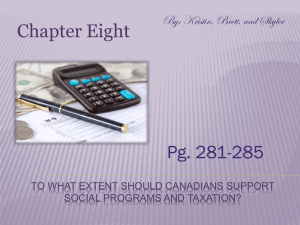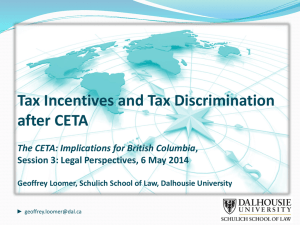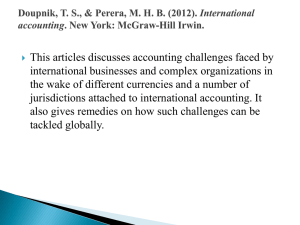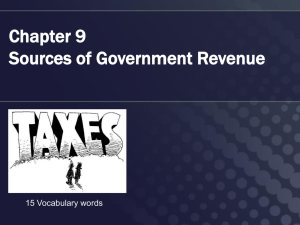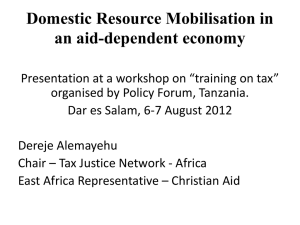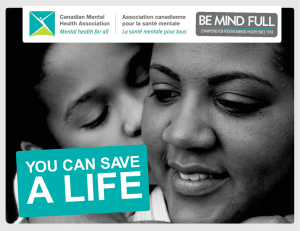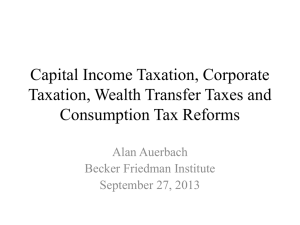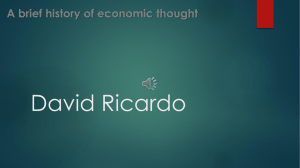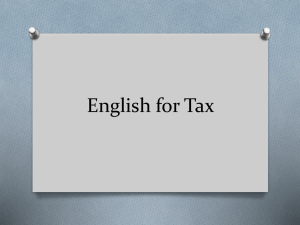Chapter 8
advertisement
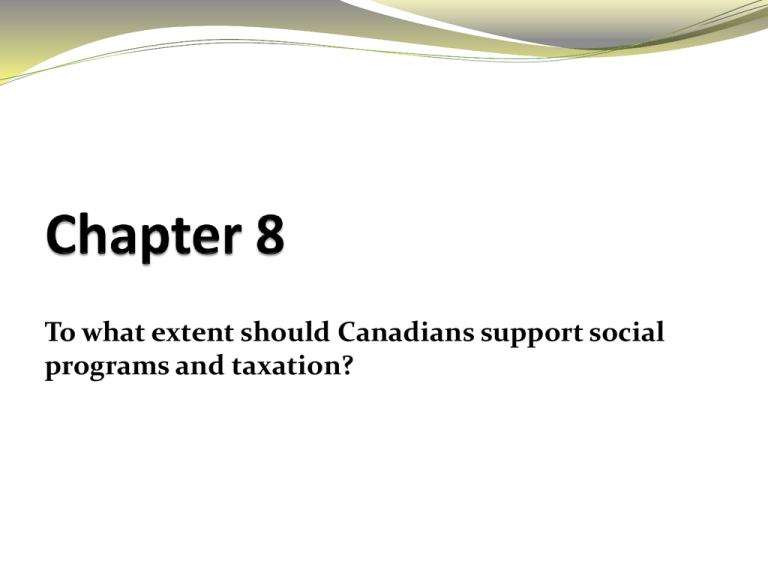
To what extent should Canadians support social programs and taxation? What are social programs? Services provided by the government and paid for by taxes. Aim to reduce economic inequalities and promote the well-being of all citizens. Examples of social programs: health care, pensions, income assistance, education, affordable housing, child care services, employment insurance Social Programs in Canada Primary value = COLLECTIVISM – providing for society as a whole is important belief that all people should have equal access to services considered essential (health care, pensions, income assistance, etc…) take care of those groups who may not be able to provide for themselves social programs should be publicly funded using tax dollars Government Responsibilities: pass legislation to protect delivery of publicly funded essential services laws against private health care appropriate taxes to cover expenses of social programs provide for those who cannot provide for themselves Examine the chart on p. 273 and record the following: What social programs are provided? How is each program provided? How is the government involved? Health care in Canada Under the Canada Health Act (1984), health care is to be administered by each province. Every province and territory must provide health care which respects the following principles: 1. Universality – available to everyone 2. Accessibility – available within reasonable time and distance 3. Comprehensiveness – applies to care provided by hospitals, physicians, surgeons 4. Portability – available everywhere in Canada, no matter where you make your home 5. Public administration – run by government for no profit Sustainability of the Public Health Care System In some Canadian provinces, including Alberta, there has been debate related to the interpretation of the Canada Health Act. Specifically, to what extent the public health care system can or should allow privatization of some health care services either alongside or within the public system. For example, in Alberta, private clinics offer MRIs to those who are willing to pay for the service. Other social programs in Canada Maternity Benefits EI/Maternity benefits allow new parents to stay with their newborn child for up to 50 weeks. 15 weeks maternity benefit for the mother 35 weeks for parental or adoptive benefits which can be shared by both parents Pension Plans Canada Pension Plan (CPP) or Quebec Pension Plan (QPP) covers all employees and self-employed Canadians who pay into the plan. Monthly benefits can start at age 60 Issues with Canadian Social Programs Affordability of social programs and health services will be affected by the aging population and the ability of the working population to support these costs. The proportion of the population aged 65 and over will triple from 1976 to 2051. Health care costs, as of 2008, are increasing by at least 8% a year. With this in mind... How can we afford health care in the future? Should we allow privatization of some health care services either alongside or within the public system? Social Programs in the U.S.A. Primary value = INDIVIDUALISM – belief that people should provide for themselves only very low-income earners should qualify for publicly funded social programs (limited access). less public funding and more privately funded social care for-profit: guided by supply and demand in a market economy Government Responsibilities: federal and state governments can make laws regarding social programs no legislation identifies responsibilities in this area. Social Programs in the USA Healthcare publicly funded care is only accessible to low income citizens all other citizens must pay for health services or health insurance individually (private health care) healthcare is like a business (for profit). Income Assistance (social security) citizens unable to meet their basic needs receive income assistance (VERY LIMITED) supported through taxation Pensions and Senior Care seniors generally have to support themselves Think about it… Why might the values that shape social programs change over time? How are the American and Canadian Health care programs different? Taxation Programs Government collects taxes to pay for the services it provides to its citizens. Taxation model –policy that guides a government in deciding what to tax, how much, and how to spend tax $$. In Canada, both the federal and provincial governments collect taxes. Canadian citizens pay two kinds of tax to the Federal government: Income Tax pay a percentage based on earnings - comes off your pay check or the profit you claim when submitting your taxes the more you earn, the more you pay in taxes. Sales Taxes: tax paid at the time of buying a product or service a percentage of the total purchase – the more you spend, the more you pay. Everyone in Canada pays the GST (goods and services tax). All provinces (except Alberta) also have a PST (Provincial Sales Tax). What is the connection between taxation and social programs? Social programs cost money! Where does the government get this money? TAXATION! Taxation levels are established so as to meet the costs of public sector needs. If public sector needs are increased or decreased, such as in changes to social programs, the taxation levels can be adjusted up or down accordingly. Examine the pie charts on p. 282 of your textbook to discover how money from taxation is spent in Canada. The Canada Revenue Agency (CRA) Administers tax laws for the federal government and for most provinces and territories Administers various social and economic benefit and incentive programs delivered through the tax system Promotes compliance with Canada’s tax legislation and regulations Plays an important role in the economic and social well-being of Canadians by ensuring, as far as possible, that all due taxes are declared and collected through extensive audits Tax and Revenue Administration (TRA), Alberta Finance and Enterprise Administers tax laws for the Alberta government Has four branches: Revenue Operations, Audit, Tax Services, and Business Technology Management Visit the Alberta Finance and Enterprise website for specific TRA responsibilities and functions. Taxation reflects economic values Taxation models depend on economic values In general… Free Market System: reduce taxes and allow business to flourish spend tax $ on limited social programming and essential services Mixed System: increase taxes and ensure appropriate level of corporate taxes to pay for social services ensure balance between private business and public good. Did you know… Grade 9 students working part-time jobs generally don’t pay income tax because they earn below the minimum amount. In 2005, Canadian families paid, on average, 17% of their income in taxes. If your family earned $67000 (median income), you would be taxed $11000. Tax Evasion and Tax Avoidance When individuals avoid paying taxes (tax evasion)or under report their income (tax avoidance), they are limiting the funds available to a government to pay for social services (tax base). Tax evasion and tax avoidance are against the law and can have criminal consequences. The Underground Economy Some people work in what is called the underground economy– which means they are working without paying taxes (“paying under the table”) or selling goods that are not being taxed (“black market”) This reduces the tax base. What effect will this type of economic activity have on the quality of life of our citizens? How does the underground economy impact the federal and provincial tax base and social programs? The government collects less tax $$ less money to spend may not be able to support social programs Canada’s Auditor General reported that tax arrangements for foreign affiliates (through offshore tax havens) have eroded Canadian tax revenues of hundreds of millions of dollars over the past 10 years. (individuals stockpiling profits and funds in banks around the world). For Homework… Define each of the following terms in your own words and then provide an example. Goods and Services Tax (GST) Income Tax Median Sales Tax Black Market Tax Evasion Taxation Model Underground Economy Tax Base Political Parties The Canada Elections Act defines a political party as “an organization whose fundamental purpose is to participate in public affairs by endorsing one or more of its members as candidates and supporting their election to the House of Commons.” Political parties develop a set of policies, known as their platform, to attract voters and get their candidates elected. Members of a political party must support and live up to the party’s platform (“towing the party line”) Political Platforms Political parties publically advertise their platforms so voters are aware of what they stand for. Political platforms: identify which issues are of the greatest concern to that party. explain what actions that party intends to take to resolve the issues. indicate if the party wants more or less government intervention. What’s the connection between values, policies and the economic continuum? Values shape both economic and social policies Value: The public good comes from cooperation Policies: government should be active in the economy and provide extensive social programs Taxation model: high taxes to pay for social programs Value: Individuals are responsible for their own well being Policies: no government intervention in economy or social programs Taxation model: low taxes due to extremely limited social programs Learn alberta.ca Left wing Center Right Wing Left Wing more government involvement and ownership in the economy increased taxes to pay for more extensive social programming increased government spending on the people and environment increased restriction on big business and economy. Right Wing less government involvement and ownership in the economy decreased taxes due to decreased government spending on the people and environment decreased restriction on big business and economy (incentives are often provided to influence economic growth) Centre primarily private ownership in the economy with some government intervention and ownership of key industries medium rates of taxation to pay for stable base of social programming government balances restriction and incentive on business. Canadian Political Parties There are 5 major federal political parties in Canada: Bloc Quebecois, Conservative Party of Canada, Green Party of Canada, Liberal Party of Canada and New Democratic Party of Canada Read through the information about each party’s major issues and economic policies found on p. 287 – 290 of the textbook. Organize the information about the economic policies in a chart. Canadian Political Platforms Left Wing (Green, Bloc, NDP): citizens should be able to rely on their government for support during difficult economic times. the government should protect its citizens socially and economically. Increased access to government services and argue for social change. COLLECTIVE GOOD Right Wing (Conservative): citizens should rely less on the government for their personal wellbeing the government should only protect the severely impoverished and all others can and should take of themselves. reduced access to government services and try to maintain the status quo. INDIVIDUAL RESPONSIBILITY Canadian Political Platforms Centre (Liberal): citizens should be encouraged to achieve their personal well-being on their own but have a social support system in place to protect during times of need attempt to balance the status quo with social change What party best aligns with your beliefs? Complete political spectrum quiz Left Right American Political Parties The are 2 major federal political parties in the United States: Democratic Party and Republican Party Read through the information about each party’s major issues and economic policies found on p. 290 of the textbook. American Political Platforms Republican Party (Right wing): firm belief in private enterprise and limited government intervention in the economy. cut government spending, lower taxes, and allow market and consumers to solve economic, social, and environmental issues (to an extent) strong traditionalist values – Catholic values and equal opportunity for business Democratic Party (Centre/right): favors more government spending on social programs and less likely to cut taxes more Liberal values and more open to change Left Right Complete worksheet “Personal Political Philosophy” Where does each party fit on the economic conundrum? If these were Canadian parties, what party would they be? Complete Government Decisions and Quality of Life Assignment Imagine you are a member of a federal political party in Canada. A lobby group recently came to you with the proposal that the federal government should create a social program that allows all Canadians to attend university for free. Some questions need to be addressed: • How will the government pay for it? • How will your constituents feel about this? • What are some negative consequences • What are some positive consequences? Get together in groups of 5. Each group will be given a political party that they must represent. Your “party” must decide how you feel about this proposal and if you will support it or not. Remember you must represent your party (tow the party line) Chapter 8 Review Package
